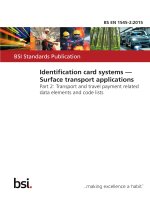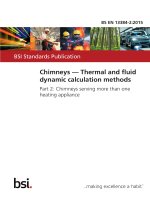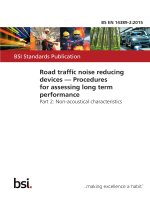Bsi bs en 61675 2 2015
Bạn đang xem bản rút gọn của tài liệu. Xem và tải ngay bản đầy đủ của tài liệu tại đây (2.1 MB, 68 trang )
BS EN 61675-2:2015
BSI Standards Publication
Radionuclide imaging
devices — Characteristics
and conditions
Part 2: Gamma cameras for planar,
wholebody, and SPECT imaging
BRITISH STANDARD
BS EN 61675-2:2015
National foreword
This British Standard is the UK implementation of EN 61675-2:2015. It is
identical to IEC 61675-2:2015. It supersedes BS EN 61675-2:1998, BS EN
61675-3:1998 and BS EN 60789:2005, which will be withdrawn on 10
September 2018.
The UK participation in its preparation was entrusted by Technical
Committee CH/62, Electrical Equipment in Medical Practice, to
Subcommittee CH/62/3, Equipment for radiotherapy, nuclear medicine
and radiation dosimetry.
A list of organizations represented on this committee can be obtained on
request to its secretary.
This publication does not purport to include all the necessary provisions of
a contract. Users are responsible for its correct application.
© The British Standards Institution 2015.
Published by BSI Standards Limited 2015
ISBN 978 0 580 84670 0
ICS 11.040.50
Compliance with a British Standard cannot confer immunity from
legal obligations.
This British Standard was published under the authority of the
Standards Policy and Strategy Committee on 30 November 2015.
Amendments/corrigenda issued since publication
Date
Text affected
BS EN 61675-2:2015
EUROPEAN STANDARD
EN 61675-2
NORME EUROPÉENNE
EUROPÄISCHE NORM
November 2015
ICS 11.040.50
Supersedes EN 60789:2005, EN 61675-2:1998, EN
61675-3:1998
English Version
Radionuclide imaging devices - Characteristics and conditions Part 2: Gamma cameras for planar, wholebody, and SPECT
imaging
(IEC 61675-2:2015)
Dispositifs d'imagerie par radionucléides - Caractéristiques
et conditions d'essai - Partie 2: Gamma-caméras pour
l'imagerie planaire, l'imagerie du corps entier et l'imagerie
SPECT
(IEC 61675-2:2015)
Bildgebende Systeme in der Nuklearmedizin - Merkmale
und Prüfbedingungen - Teil 2: Gammakameras für planare
Bildgebung, mit Ganzkörper-Zusatz und Gammakameras
zur Einzelphotonen-Emissions-Tomographie (SPECT)
(IEC 61675-2:2015)
This European Standard was approved by CENELEC on 2015-09-10. CENELEC members are bound to comply with the CEN/CENELEC
Internal Regulations which stipulate the conditions for giving this European Standard the status of a national standard without any alteration.
Up-to-date lists and bibliographical references concerning such national standards may be obtained on application to the CEN-CENELEC
Management Centre or to any CENELEC member.
This European Standard exists in three official versions (English, French, German). A version in any other language made by translation
under the responsibility of a CENELEC member into its own language and notified to the CEN-CENELEC Management Centre has the
same status as the official versions.
CENELEC members are the national electrotechnical committees of Austria, Belgium, Bulgaria, Croatia, Cyprus, the Czech Republic,
Denmark, Estonia, Finland, Former Yugoslav Republic of Macedonia, France, Germany, Greece, Hungary, Iceland, Ireland, Italy, Latvia,
Lithuania, Luxembourg, Malta, the Netherlands, Norway, Poland, Portugal, Romania, Slovakia, Slovenia, Spain, Sweden, Switzerland,
Turkey and the United Kingdom.
European Committee for Electrotechnical Standardization
Comité Européen de Normalisation Electrotechnique
Europäisches Komitee für Elektrotechnische Normung
CEN-CENELEC Management Centre: Avenue Marnix 17, B-1000 Brussels
© 2015 CENELEC All rights of exploitation in any form and by any means reserved worldwide for CENELEC Members.
Ref. No. EN 61675-2:2015 E
BS EN 61675-2:2015
EN 61675-2:2015
European foreword
The text of document 62C/616/FDIS, future edition 2 of IEC 61675-2, prepared by IEC/SC 62C
"Equipment for radiotherapy, nuclear medicine and radiation dosimetry" of IEC/TC 62 "Electrical
equipment in medical practice" was submitted to the IEC-CENELEC parallel vote and approved by
CENELEC as EN 61675-2:2015.
The following dates are fixed:
•
•
latest date by which the document has
to be implemented at national level by
publication of an identical national
standard or by endorsement
latest date by which the national
standards conflicting with the
document have to be withdrawn
(dop)
2016-06-10
(dow)
2018-09-10
This document supersedes EN 61675-2:1998 and A1:2005, EN 60789:2005 and EN 61675-3:1998.
Attention is drawn to the possibility that some of the elements of this document may be the subject of
patent rights. CENELEC [and/or CEN] shall not be held responsible for identifying any or all such
patent rights.
Endorsement notice
The text of the International Standard IEC 61675-2:2015 was approved by CENELEC as a European
Standard without any modification.
In the official version, for Bibliography, the following notes have to be added for the standards
indicated:
2
IEC 60601-1:2005
A1:2012
NOTE Harmonized as EN 60601-1:2006 (not modified).
A1:2013
IEC 61675-1:2013
NOTE Harmonized as EN 61675-1:2014 (not modified).
BS EN 61675-2:2015
EN 61675-2:2015
Annex ZA
(normative)
Normative references to international publications
with their corresponding European publications
The following documents, in whole or in part, are normatively referenced in this document and are
indispensable for its application. For dated references, only the edition cited applies. For undated
references, the latest edition of the referenced document (including any amendments) applies.
NOTE 1 When an International Publication has been modified by common modifications, indicated by (mod), the relevant
EN/HD applies.
NOTE 2 Up-to-date information on the latest versions of the European Standards listed in this annex is available here:
www.cenelec.eu.
Publication
IEC/TR 60788
Year
2004
Title
EN/HD
Medical electrical equipment - Glossary of defined terms
Year
-
IEC 61675-1
2013
Radionuclide imaging devices EN 61675-1
Characteristics and test conditions -- Part
1: Positron emission tomographs
2014
3
–2–
BS EN 61675-2:2015
IEC 61675-2:2015 © IEC 2015
CONTENTS
FOREWORD ........................................................................................................................... 4
INTRODUCTION ..................................................................................................................... 6
1
Scope .............................................................................................................................. 7
2
Normative references ....................................................................................................... 7
3
Terms and definitions....................................................................................................... 7
4
Test methods ................................................................................................................. 15
4.1
General ................................................................................................................. 15
4.2
Planar imaging ...................................................................................................... 16
4.2.1
S YSTEM SENSITIVITY ...................................................................................... 16
4.2.2
S PATIAL RESOLUTION ..................................................................................... 18
4.2.3
S PATIAL NON - LINEARITY .................................................................................. 24
4.2.4
N ON - UNIFORMITY OF RESPONSE ...................................................................... 25
4.2.5
I NTRINSIC ENERGY RESOLUTION ....................................................................... 28
4.2.6
Intrinsic MULTIPLE WINDOW SPATIAL REGISTRATION .......................................... 29
4.2.7
C OUNT RATE performance ............................................................................. 31
4.2.8
Shield leakage test ....................................................................................... 33
4.3
Wholebody imaging ............................................................................................... 33
4.3.1
Scanning constancy ..................................................................................... 33
4.3.2
S PATIAL RESOLUTION without scatter .............................................................. 36
4.4
Tomographic imaging (SPECT) ............................................................................. 37
4.4.1
Test of PROJECTION geometry ....................................................................... 37
4.4.2
Measurement of SPECT SYSTEM SENSITIVITY ................................................. 41
4.4.3
Scatter measurement ................................................................................... 44
4.4.4
SPECT SYSTEM SPATIAL RESOLUTION ............................................................. 48
4.4.5
Tomographic image quality ........................................................................... 50
5
Accompanying documents .............................................................................................. 57
5.1
General ................................................................................................................. 57
5.2
General parameters for GAMMA CAMERAS ................................................................ 58
5.2.1
C OLLIMATORS ................................................................................................ 58
5.2.2
Shield leakage values .................................................................................. 58
5.2.3
Pre-set PULSE AMPLITUDE ANALYSER WINDOWS ................................................ 58
5.2.4
I NTRINSIC ENERGY RESOLUTION ....................................................................... 58
5.2.5
COLLIMATOR dependent quantities ................................................................. 58
5.2.6
C OUNT RATE CHARACTERISTICS ....................................................................... 58
5.2.7
Measured COUNT RATE that is 80 % of the corresponding TRUE COUNT
RATE .............................................................................................................. 58
5.2.8
Dimensions of the DETECTOR FIELD OF VIEW ................................................... 58
5.2.9
Non-uniformity characteristics ...................................................................... 58
5.2.10
I NTRINSIC SPATIAL RESOLUTION (FWHM and EW) of the DETECTOR HEAD
without COLLIMATOR ........................................................................................ 58
5.2.11
I NTRINSIC SPATIAL NON - LINEARITY ................................................................... 58
5.2.12
Intrinsic MULTIPLE WINDOW SPATIAL REGISTRATION .......................................... 59
5.3
G AMMA CAMERA based wholebody imaging system ................................................. 59
5.3.1
Scanning constancy ..................................................................................... 59
5.3.2
S PATIAL RESOLUTION ..................................................................................... 59
5.4
SPECT .................................................................................................................. 59
BS EN 61675-2:2015
IEC 61675-2:2015 © IEC 2015
–3–
5.4.1
Calibration measurements of COR ............................................................... 59
5.4.2
Measurement of head tilt .............................................................................. 59
5.4.3
Measurement of COLLIMATOR hole misalignment ............................................ 59
5.4.4
T RANSVERSE RESOLUTION (radial and tangential) ............................................ 59
5.4.5
A XIAL RESOLUTION ......................................................................................... 59
5.4.6
Axial PIXEL size ............................................................................................ 59
5.4.7
Transaxial PIXEL size .................................................................................... 59
5.4.8
D ETECTOR POSITIONING TIME .......................................................................... 59
5.4.9
N ORMALIZED VOLUME SENSITIVITY ................................................................... 59
5.4.10
S CATTER FRACTIONS SF i and SF .................................................................... 59
5.4.11
Scan set up and phantom ACTIVITY concentration .......................................... 59
5.4.12
Image quality ............................................................................................... 59
5.4.13
Accuracy of ATTENUATION correction and scatter correction ........................... 59
5.4.14
Accuracy of SPECT and CT image registration ............................................. 59
Index of defined terms ........................................................................................................... 60
Bibliography .......................................................................................................................... 62
Figure 1 – Geometry of PROJECTIONS ....................................................................................... 9
Figure 2 – Cylindrical phantom .............................................................................................. 14
Figure 3 – Cuvette ................................................................................................................. 17
Figure 4 – Slit phantom ......................................................................................................... 19
Figure 5 – Source arrangement for intrinsic measurements ................................................... 20
Figure 6 – Calculation of FWHM ............................................................................................ 22
Figure 7 – Evaluation of equivalent width (EW) ...................................................................... 23
Figure 8 – Uniform source ..................................................................................................... 26
Figure 9 – Small shielded liquid source .................................................................................. 29
Figure 10 – Source positions for scanning constancy for wholebody imaging .......................... 35
Figure 11 – Cylindrical phantom ............................................................................................ 43
Figure 12 – Phantom insert with holders for the scatter source .............................................. 45
Figure 13 – Evaluation of scatter fraction ............................................................................... 47
Figure 14 – Reporting transverse resolution ........................................................................... 49
Figure 15 – Cross-section of body phantom ........................................................................... 51
Figure 16 – Phantom insert with hollow spheres .................................................................... 52
Figure 17 – Placement of ROIs in the phantom background ................................................... 55
Table 1 – R ADIONUCLIDES and ENERGY WINDOWS to be used for performance
measurements ...................................................................................................................... 16
–4–
BS EN 61675-2:2015
IEC 61675-2:2015 © IEC 2015
INTERNATIONAL ELECTROTECHNICAL COMMISSION
____________
RADIONUCLIDE IMAGING DEVICES –
CHARACTERISTICS AND TEST CONDITIONS –
Part 2: Gamma cameras for planar, wholebody,
and SPECT imaging
FOREWORD
1) The International Electrotechnical Commission (IEC) is a worldwide organization for standardization comprising
all national electrotechnical committees (IEC National Committees). The object of IEC is to promote
international co-operation on all questions concerning standardization in the electrical and electronic fields. To
this end and in addition to other activities, IEC publishes International Standards, Technical Specifications,
Technical Reports, Publicly Available Specifications (PAS) and Guides (hereafter referred to as “IEC
Publication(s)”). Their preparation is entrusted to technical committees; any IEC National Committee interested
in the subject dealt with may participate in this preparatory work. International, governmental and nongovernmental organizations liaising with the IEC also participate in this preparation. IEC collaborates closely
with the International Organization for Standardization (ISO) in accordance with conditions determined by
agreement between the two organizations.
2) The formal decisions or agreements of IEC on technical matters express, as nearly as possible, an international
consensus of opinion on the relevant subjects since each technical committee has representation from all
interested IEC National Committees.
3) IEC Publications have the form of recommendations for international use and are accepted by IEC National
Committees in that sense. While all reasonable efforts are made to ensure that the technical content of IEC
Publications is accurate, IEC cannot be held responsible for the way in which they are used or for any
misinterpretation by any end user.
4) In order to promote international uniformity, IEC National Committees undertake to apply IEC Publications
transparently to the maximum extent possible in their national and regional publications. Any divergence
between any IEC Publication and the corresponding national or regional publication shall be clearly indicated in
the latter.
5) IEC itself does not provide any attestation of conformity. Independent certification bodies provide conformity
assessment services and, in some areas, access to IEC marks of conformity. IEC is not responsible for any
services carried out by independent certification bodies.
6) All users should ensure that they have the latest edition of this publication.
7) No liability shall attach to IEC or its directors, employees, servants or agents including individual experts and
members of its technical committees and IEC National Committees for any personal injury, property damage or
other damage of any nature whatsoever, whether direct or indirect, or for costs (including legal fees) and
expenses arising out of the publication, use of, or reliance upon, this IEC Publication or any other IEC
Publications.
8) Attention is drawn to the Normative references cited in this publication. Use of the referenced publications is
indispensable for the correct application of this publication.
9) Attention is drawn to the possibility that some of the elements of this IEC Publication may be the subject of
patent rights. IEC shall not be held responsible for identifying any or all such patent rights.
International Standard IEC 61675-2 has been prepared by subcommittee 62C: Equipment for
radiotherapy, nuclear medicine and radiation dosimetry, of IEC technical committee 62:
Electrical equipment in medical practice.
This second edition of IEC 61675-2 cancels and replaces the first edition published in 1998 and
its Amendment 1 published in 2004, as well as IEC 60789:2005, IEC 60789:2005/COR1:2009,
and IEC 61675-3:1998. It has been reformatted, updated, and partly aligned with NEMA NU 12007. Due to the lack of market share of SPECT-systems operated in coincidence mode all
such tests have been removed.
BS EN 61675-2:2015
IEC 61675-2:2015 © IEC 2015
–5–
The text of this standard is based on the following documents:
FDIS
Report on voting
62C/616/FDIS
62C/623/RVD
Full information on the voting for the approval of this standard can be found in the report on
voting indicated in the above table.
This publication has been drafted in accordance with the ISO/IEC Directives, Part 2.
In this standard, the following print types are used:
–
TERMS DEFINED IN CLAUSE
SMALL CAPITALS .
2 OF THIS STANDARD OR LISTED IN THE INDEX OF DEFINED TERMS :
The requirements are followed by specifications for the relevant tests.
Annex A is for information only.
The committee has decided that the contents of this publication will remain unchanged until the
stability date indicated on the IEC website under "" in the data related to
the specific publication. At this date, the publication will be
•
reconfirmed,
•
withdrawn,
•
replaced by a revised edition, or
•
amended.
–6–
BS EN 61675-2:2015
IEC 61675-2:2015 © IEC 2015
INTRODUCTION
The test methods specified in this part of IEC 61675 have been selected to reflect as much as
possible the clinical use of GAMMA CAMERAS for planar imaging, PLANAR WHOLEBODY IMAGING
EQUIPMENT , and SINGLE PHOTON EMISSION COMPUTED TOMOGRAPHY (SPECT). It is intended that
the test methods are carried out by manufacturers thereby enabling them to describe the
characteristics of the systems on a common basis.
BS EN 61675-2:2015
IEC 61675-2:2015 © IEC 2015
–7–
RADIONUCLIDE IMAGING DEVICES –
CHARACTERISTICS AND TEST CONDITIONS –
Part 2: Gamma cameras for planar, wholebody,
and SPECT imaging
1
Scope
This part of IEC 61675 specifies terminology and test methods for describing the characteristics of GAMMA CAMERAS equipped with PARALLEL HOLE COLLIMATORS for planar imaging.
Additional tests are specified for those GAMMA CAMERAS that are capable of planar wholebody
imaging ( PLANAR WHOLEBODY IMAGING EQUIPMENT ) or SINGLE PHOTON EMISSION COMPUTED
TOMOGRAPHY (SPECT). These GAMMA CAMERAS consist of a gantry, single or multiple DETECTOR
HEADS , and a computer for data acquisition, processing, storage, and display. The DETECTOR
HEADS may contain single or multiple scintillation crystals or solid state detectors.
No test has been specified to characterize the uniformity of reconstructed images because all
methods known so far will mostly reflect the noise of the image.
2
Normative references
The following documents, in whole or in part, are normatively referenced in this document and
are indispensable for its application. For dated references, only the edition cited applies. For
undated references, the latest edition of the referenced document (including any amendments)
applies.
IEC 60788:2004, Medical electrical equipment – Glossary of defined terms
IEC 61675-1:2013, Radionuclide imaging devices – Characteristics and test conditions –
Part 1: Positron emission tomographs
3
Terms and definitions
For the purposes of this document the terms and definitions given in IEC 60788 and
IEC 61675-1 (some of which are repeated here for convenience), and the following terms and
definitions apply.
3.1
ADDRESS PILE UP
< GAMMA CAMERA > false address calculation of an artificial event which
WINDOW , but is formed from two or more events by the PILE UP EFFECT
passes the ENERGY
3.2
AXIAL FIELD OF VIEW
dimensions of a slice through the TOMOGRAPHIC VOLUME parallel to and including the SYSTEM
AXIS
Note 1 to entry: In practice it is specified only by its axial dimension given by the distance between the centres of
the outermost defined IMAGE PLANES plus the average of the measured AXIAL SLICE W IDTH measured as EQUIVALENT
W IDTH (EW).
–8–
BS EN 61675-2:2015
IEC 61675-2:2015 © IEC 2015
3.3
AXIAL RESOLUTION
for tomographs with sufficiently fine axial sampling fulfilling the sampling theorem, SPATIAL
RESOLUTION along a line parallel to the SYSTEM AXIS
3.4
CENTRE OF ROTATION
COR
origin of that coordinate system, which describes the PROJECTIONS of a transverse slice with
respect to their orientation in space
Note 1 to entry: The CENTRE OF ROTATION of a transverse slice is given by the intersection of the SYSTEM AXIS with
the mid-plane of the corresponding OBJECT SLICE .
Note 2 to entry:
The second note to entry concerns the French text only.
3.5
COLLIMATOR AXIS
straight line which passes through the geometrical centre of the exit field and entrance field of
the COLLIMATOR
3.6
COLLIMATOR FRONT FACE
surface of the COLLIMATOR which is closest to the object being imaged
3.7
COORDINATE SYSTEM OF PROJECTION
Cartesian system of the IMAGE MATRIX
Yp
of each two-dimensional PROJECTION with axes X p and
Note 1 to entry:
Axes X p and Y p are defined by the axes of the IMAGE MATRIX .
Note 2 to entry:
parallel.
The Y p axis and the PROJECTION of the SYSTEM AXIS onto the detector front face have to be in
Note 3 to entry:
Figure 1).
The origin of the COORDINATE SYSTEM OF PROJECTION may be the centre of the IMAGE MATRIX (see
BS EN 61675-2:2015
IEC 61675-2:2015 © IEC 2015
–9–
IEC
NOTE The FIXED COORDINATE SYSTEM X, Y, Z has its origin at the centre of the TOMOGRAPHIC VOLUME (shown as a
cylinder), the Z-axis being the SYSTEM AXIS . The COORDINATE SYSTEM OF PROJECTION X p , Y p is shown for a
PROJECTION ANGLE θ . For each θ , the one-dimensional PROJECTION of the marked OBJECT SLICE has the address
range shown (hatched). Within this range the CENTRE OF ROTATION is projected onto the address X p (offset).
Figure 1 – Geometry of PROJECTIONS
3.8
COUNT LOSS
difference between measured COUNT RATE and TRUE COUNT RATE , which is caused by the finite
RESOLVING TIME of the instrument
[SOURCE: IEC 61675-1:2013, 3.8.1]
3.9
COUNT RATE
number of counts per unit of time
[SOURCE: IEC 61675-1:2013, 3.8.2]
3.10
COUNT RATE CHARACTERISTIC
function giving the relationship between observed COUNT RATE and TRUE COUNT RATE
– 10 –
BS EN 61675-2:2015
IEC 61675-2:2015 © IEC 2015
[SOURCE: IEC 60788:2004, rm-34-21]
3.11
DETECTOR FIELD OF VIEW
FOV
region of the detector within which events are included in the display image, and for which all
performance specifications are provided
Note 1 to entry:
The note to entry regarding the abbreviation concerns the French text only.
3.12
DETECTOR HEAD TILT
deviation of the COLLIMATOR AXIS from orthogonality with the SYSTEM AXIS
3.13
DETECTOR POSITIONING TIME
fraction of the total time spent on an acquisition which is not used in collecting data
3.14
EMISSION COMPUTED TOMOGRAPHY
ECT
imaging method for the representation of the spatial distribution of RADIONUCLIDES in selected
two-dimensional slices through the object
3.15
ENERGY WINDOW
range defining the energy signals accepted by the device for further processing
3.16
EQUIVALENT WIDTH
EW
width of that rectangle having the same area and the same height as the response function,
e.g. the POINT SPREAD FUNCTION
[SOURCE: IEC 60788:2004, rm-34-45]
3.17
FIXED COORDINATE SYSTEM
Cartesian system with axes X, Y, and Z
Note 1 to entry:
Z being the SYSTEM AXIS .
Note 2 to entry:
(see Figure 1).
The origin of the FIXED COORDINATE SYSTEM is defined by the centre of the TOMOGRAPHIC VOLUME
Note 3 to entry:
The SYSTEM AXIS is orthogonal to all transverse slices.
3.18
IMAGE MATRIX
arrangement of MATRIX ELEMENTS in a preferentially Cartesian coordinate system
3.19
IMAGE PLANE
plane assigned to a plane in the OBJECT SLICE
Note 1 to entry:
Usually the IMAGE PLANE is the mid-plane of the corresponding OBJECT SLICE .
BS EN 61675-2:2015
IEC 61675-2:2015 © IEC 2015
– 11 –
3.20
INTRINSIC ENERGY RESOLUTION
FULL WIDTH AT HALF MAXIMUM of the
SPECTRUM for a specified RADIONUCLIDE
full energy absorption peak in the INTRINSIC ENERGY
3.21
INTRINSIC ENERGY SPECTRUM
measured histogram of pulse heights for the DETECTOR HEAD without COLLIMATOR
Note 1 to entry:
The pulse height should be expressed as corresponding energy.
3.22
INTRINSIC NON - UNIFORMITY OF RESPONSE
NON - UNIFORMITY OF RESPONSE of the DETECTOR HEAD
without COLLIMATOR
3.23
INTRINSIC SPATIAL NON - LINEARITY
SPATIAL NON - LINEARITY of the DETECTOR HEAD
without COLLIMATOR
3.24
INTRINSIC SPATIAL RESOLUTION
< GAMMA CAMERA > SPATIAL RESOLUTION
COLLIMATOR
in air for a specified RADIONUCLIDE measured without the
3.25
LINE SOURCE
straight RADIOACTIVE SOURCE approximating a δ-function in two dimensions and being constant
(uniform) in the third dimension
3.26
MATRIX ELEMENT
smallest unit of an IMAGE MATRIX, which is assigned in location and size to a certain volume
element of the object ( VOXEL )
3.27
MULTIPLE WINDOW SPATIAL REGISTRATION
measured position of a source as a function of the ENERGY WINDOW setting
3.28
NORMALIZED VOLUME SENSITIVITY
VOLUME SENSITIVITY divided by the AXIAL FIELD OF VIEW
whichever is the smaller
of the tomograph or the phantom length,
3.29
OBJECT SLICE
slice in the object
Note 1 to entry: The physical property of this slice that determines the measured information is displayed in the
tomographic image.
3.30
OFFSET
deviation of the position of the PROJECTION of the COR (X' p ) from X p = 0 (see Figure 1)
3.31
PARALLEL HOLE COLLIMATOR
COLLIMATOR with a number of
apertures, the axes of which are parallel
– 12 –
BS EN 61675-2:2015
IEC 61675-2:2015 © IEC 2015
3.32
PILE UP EFFECT
false measurement of the pulse amplitude, due to the absorption of two or more gamma rays,
reaching the same radiation detector within the RESOLVING TIME
3.33
PIXEL
MATRIX ELEMENT
in a two-dimensional IMAGE MATRIX
3.34
PLANAR WHOLEBODY IMAGING EQUIPMENT
< GAMMA CAMERA > GAMMA CAMERA , with one or two DETECTOR HEAD ( S ), in which the image of an
extended object is formed by moving the DETECTOR HEAD ( S ) or the object in the axial direction
relative to each other
3.35
POINT SOURCE
RADIOACTIVE SOURCE
approximating a δ-function in all three dimensions
3.36
POINT SPREAD FUNCTION
PSF
scintigraphic image of a POINT SOURCE
3.37
PROJECTION
transformation of a three-dimensional object into its two-dimensional image or of a twodimensional object into its one-dimensional image, by integrating the physical property which
determines the image along the direction of the PROJECTION BEAM
Note 1 to entry: This process is mathematically described by line integrals in the direction of PROJECTION and
called the Radon-transform.
3.38
PROJECTION ANGLE
angle at which the PROJECTION is measured or acquired
Note 1 to entry:
See Figure 1.
3.39
PROJECTION BEAM
determines the smallest possible volume in which the physical property which determines the
image is integrated during the measurement process
Note 1 to entry:
Its shape is limited by the SPATIAL RESOLUTION in all three dimensions.
Note 2 to entry:
In SPECT the PROJECTION BEAM usually has the shape of a long thin diverging cone.
3.40
RADIAL RESOLUTION
TRANSVERSE RESOLUTION
SYSTEM AXIS
along a line passing through the position of the source and the
[SOURCE: IEC 61675-1:2013, 3.4.1.1]
3.41
RADIOACTIVE SOURCE
quantity of radioactive material having both an ACTIVITY and a specific ACTIVITY above specific
levels
BS EN 61675-2:2015
IEC 61675-2:2015 © IEC 2015
– 13 –
[SOURCE: IEC 60788:2004, rm-20-02]
3.42
RADIUS OF ROTATION
distance between the SYSTEM AXIS and the COLLIMATOR FRONT FACE
3.43
SCATTER FRACTION
SF
< GAMMA CAMERA > ratio between the number of scattered photons and the sum of scattered plus
unscattered photons for a given experimental set-up
3.44
SINGLE PHOTON EMISSION COMPUTED TOMOGRAPHY
SPECT
EMISSION COMPUTED TOMOGRAPHY
RADIONUCLIDES
Note 1 to entry:
utilizing single photon detection of gamma-ray emitting
The note to entry regarding the abbreviation concerns the French version only.
3.45
SINOGRAM
two-dimensional display of all one-dimensional PROJECTIONS of an OBJECT SLICE , as a function
of the PROJECTION ANGLE
Note 1 to entry: The PROJECTION ANGLE is displayed on the ordinate, the linear PROJECTION coordinate is displayed
on the abscissa.
[SOURCE: IEC 61675-1:2013, 3.1.2.4]
3.46
SLICE SENSITIVITY
ratio of COUNT RATE as measured on the SINOGRAM to the ACTIVITY concentration in the phantom
Note 1 to entry:
SCATTER FRACTION .
In SPECT the measured counts are not numerically corrected for scatter by subtracting the
[SOURCE: IEC 61675-1:2013, 3.6]
3.47
SPATIAL NON - LINEARITY
deviations of the image of a straight LINE SOURCE from a straight line
3.48
SPATIAL RESOLUTION
<nuclear medicine> ability to concentrate the count density distribution in the image of a POINT
SOURCE to a point
[SOURCE: IEC 61675-1:2013, 3.4]
3.49
SYSTEM AXIS
axis of symmetry characterized by geometrical and physical properties of the arrangement of
the system
Note 1 to entry:
The SYSTEM AXIS of a GAMMA CAMERA with rotating detectors is the axis of rotation.
[SOURCE: IEC 61675-1:2013, 3.1.2.7, modified – The note to entry has been changed]
BS EN 61675-2:2015
IEC 61675-2:2015 © IEC 2015
– 14 –
3.50
SYSTEM NON - UNIFORMITY OF RESPONSE
NON - UNIFORMITY OF RESPONSE of the DETECTOR HEAD
with COLLIMATOR
3.51
SYSTEM SENSITIVITY
< GAMMA CAMERA > with a specified COLLIMATOR and ENERGY WINDOW , the ratio of the COUNT
RATE of the DETECTOR HEAD to the ACTIVITY of a plane source of specific dimensions and
containing a specified RADIONUCLIDE placed perpendicular to and centred on the COLLIMATOR
AXIS under specified conditions
Note 1 to entry:
See also Figure 2.
Dimensions in millimetres
∅ 300
Source
d
20
10
150
80
∅ 170
C OLLIMATOR FRONT FACE ( GAMMA CAMERA )
Material: polymethylmethacrylate
IEC
Figure 2 – Cylindrical phantom
3.52
SYSTEM SPATIAL RESOLUTION
< GAMMA CAMERA > SPATIAL RESOLUTION in a scattering medium for a specified COLLIMATOR ,
specified RADIONUCLIDE , and at a specified distance from the COLLIMATOR FRONT FACE
or a
3.53
TANGENTIAL RESOLUTION
TRANSVERSE RESOLUTION
in the direction orthogonal to the direction of RADIAL RESOLUTION
[SOURCE: IEC 61675-1:2013, 3.4.1.2]
3.54
TOMOGRAPHIC VOLUME
juxtaposition of all volume elements which contribute to the measured PROJECTIONS for all
PROJECTION ANGLES
BS EN 61675-2:2015
IEC 61675-2:2015 © IEC 2015
– 15 –
Note 1 to entry: For a rotating GAMMA CAMERA with a circular field of view the TOMOGRAPHIC VOLUME is a sphere
provided that the RADIUS OF ROTATION is larger than the radius of the field of view. For a rectangular field of view,
the TOMOGRAPHIC VOLUME is a cylinder.
[SOURCE: IEC 61675-1:2013, 3.1.2.8, modified – A note to entry has been added.]
3.55
TRANSVERSE POINT SPREAD FUNCTION
reconstructed two-dimensional POINT SPREAD FUNCTION in a tomographic IMAGE PLANE
Note 1 to entry: In TOMOGRAPHY , the TRANSVERSE POINT SPREAD FUNCTION can also be obtained from a LINE SOURCE
located parallel to the SYSTEM AXIS .
[SOURCE: IEC 61675-1:2013, 3.3.3]
3.56
TRANSVERSE RESOLUTION
SPATIAL RESOLUTION in a reconstructed
plane perpendicular to the SYSTEM AXIS
[SOURCE: IEC 61675-1:2013, 3.4.1]
3.57
VOLUME SENSITIVITY
sum of the individual SLICE SENSITIVITIES
[SOURCE: IEC 61675-1:2013, 3.7]
3.58
VOXEL
volume element in the object which is assigned to a MATRIX ELEMENT in a two- or threedimensional IMAGE MATRIX
Note 1 to entry: The dimensions of the VOXEL are determined by the dimensions of the corresponding MATRIX
ELEMENT via the appropriate scale factors and by the systems SPATIAL RESOLUTION in all three dimensions.
[SOURCE: IEC 61675-1:2013, 3.2.2]
4
4.1
Test methods
General
All measurements shall be performed with the PULSE AMPLITUDE ANALYSER WINDOW set as
specified in Table 1. Additional measurements with other settings as specified by the
manufacturer can be performed. Before the measurements are performed, the tomographic
system shall be adjusted by the procedure normally used by the manufacturer for an installed
unit and shall not be adjusted specially for the measurement of specific parameters. If any test
cannot be carried out exactly as specified in the standard, the reason for the deviation and the
exact conditions under which the test was performed shall be stated clearly.
– 16 –
BS EN 61675-2:2015
IEC 61675-2:2015 © IEC 2015
Table 1 – R ADIONUCLIDES and ENERGY WINDOWS
to be used for performance measurements
R ADIONUCLIDE
E NERGY WINDOW
keV
99mTc
141 (± 7,5 %)
131 I
364 (± 10 %)
67 Ga
93, 184, 300 (± 10 %)
57 Co
122 (± 10 %)
NOTE Because the characteristics of a GAMMA CAMERA may change noticeably between 122 keV ( 57 Co) and
141 keV ( 99mTc), the former is not included as a suitable RADIONUCLIDE . However, it may be useful in some
circumstances, e.g. for quality control.
Unless otherwise specified, each DETECTOR HEAD in the system shall be characterized by a full
data set.
Unless otherwise specified, SPECT characterization shall be provided for an acquisition
covering the minimal rotation required to obtain a complete set of data (e.g. 120° for a threeheaded system). If the tomograph is specified to operate in a non-circular orbiting mode
influencing the performance parameters, test results for the non-circular orbiting mode shall be
reported in addition.
Unless otherwise specified, measurements shall be carried out at COUNT RATES not exceeding
20 000 counts per second.
4.2
Planar imaging
4.2.1
4.2.1.1
S YSTEM SENSITIVITY
General
S YSTEM SENSITIVITY is a parameter that characterizes the effectiveness of a system to identify
the radiation emitted from a RADIOACTIVE SOURCE , i.e. the rate at which events are detected in
the presence of a RADIOACTIVE SOURCE with low ACTIVITY where COUNT LOSSES are negligible.
The measured COUNT RATE for a given ACTIVITY and RADIONUCLIDE depends on many factors,
including the detector material, its size and thickness, the size and shape of the RADIOACTIVE
SOURCE including its absorption and scatter properties, and instrument’s dead time, energy
thresholds and COLLIMATOR .
4.2.1.2
Purpose
The purpose of this measurement is to determine the detected rate of events per unit of
ACTIVITY for a standard volume source of given dimensions and a specified COLLIMATOR .
4.2.1.3
Method
The SYSTEM SENSITIVITY test places a known amount of ACTIVITY of a specified RADIONUCLIDE
within the DETECTOR FIELD OF VIEW of the GAMMA CAMERA and observes the resulting COUNT
RATE . From these values the SYSTEM SENSITIVITY is calculated. The test is critically dependent
upon accurate assays of ACTIVITY as measured in a dose calibrator or well counter. It is difficult
to maintain an absolute calibration with such devices to accuracies better than ±10 %. Absolute
reference standards of the appropriate RADIONUCLIDE should be considered if higher degrees of
accuracy are required.
BS EN 61675-2:2015
IEC 61675-2:2015 © IEC 2015
4.2.1.4
– 17 –
R ADIONUCLIDE
The RADIONUCLIDE used for this measurement shall be appropriate for the COLLIMATOR energy
specification and chosen from Table 1.
4.2.1.5
R ADIOACTIVE SOURCE distribution
The cylindrical phantom of polymethylmethacrylate as specified in Figure 2 shall be used. The
source cuvette shown in Figure 3 shall be filled with the appropriate RADIONUCLIDE and shall be
placed in the cylindrical hole with the dimensions shown in Figure 2; the remainder of the hole
shall then be filled by the cylindrical insert, the dimensions of which are also shown in Figure 2.
The phantom, including the source, shall then be placed on the COLLIMATOR FRONT FACE
(distance d = 0) and centred on the COLLIMATOR AXIS .
Dimensions in millimetres
10
∅ 150
20
∅ 170
Source
Material: polymethylmethacrylate
IEC
Figure 3 – Cuvette
NOTE Measurements of SYSTEM SENSITIVITY without scatter, using the source cuvette of Figure 3 placed at a
distance of 10 cm from the COLLIMATOR FRONT FACE , may be carried out in addition to this test.
4.2.1.6
Data collection
With an ENERGY WINDOW setting as specified in Table 1, at least 200 000 counts shall be
acquired and the data acquisition time recorded to calculate the COUNT RATE C s for all events
collected in the image.
4.2.1.7
Data processing
The ACTIVITY in the phantom shall be corrected for decay to determine the average ACTIVITY ,
A ave , during the data acquisition time interval, T acq , by the following equation
Aave =
Tacq
T − T0
Acal T1/2
exp cal
ln 2 1 − exp −
ln 2
ln 2 Tacq
T1/ 2
T1/ 2
(1)
where
T0
is the ACTIVITY measured at time T cal ;
is the acquisition start time;
T 1/2
is the RADIOACTIVE HALF - LIFE of the RADIONUCLIDE .
4.2.1.8
Data analysis
A cal
The SYSTEM SENSITIVITY S for the COLLIMATOR used shall then be found by
S=
Cs
Aave
(2)
– 18 –
BS EN 61675-2:2015
IEC 61675-2:2015 © IEC 2015
and shall be expressed in counts ⋅ s –1 ⋅ MBq –1 .
4.2.1.9
Report
Report the SYSTEM SENSITIVITY together with the COLLIMATOR and the RADIONUCLIDE used.
4.2.2
4.2.2.1
S PATIAL RESOLUTION
General
S PATIAL RESOLUTION determines the ability of an imaging system to reproduce the spatial
distribution of a RADIONUCLIDE in an object. The measurement is performed by imaging LINE
SOURCES in air without COLLIMATOR ( INTRINSIC SPATIAL RESOLUTION ) and with COLLIMATOR using
scattering material ( SYSTEM SPATIAL RESOLUTION ), respectively. The measurement of SYSTEM
SPATIAL RESOLUTION including scatter is more representative of the clinical situation when
measuring a patient, whereas the INTRINSIC SPATIAL RESOLUTION characterizes the DETECTOR
HEAD performance without the COLLIMATOR .
4.2.2.2
Purpose
The purpose of this measurement is to describe the ability of the camera to characterize small
objects.
4.2.2.3
Method
For all systems, the SPATIAL RESOLUTION shall be measured in IMAGE PLANES parallel to the
COLLIMATOR FRONT FACE by characterizing the width of the LINE SPREAD FUNCTIONS using LINE
SOURCES . The width of the LINE SPREAD FUNCTION is measured by the FULL WIDTH AT HALF
MAXIMUM (FWHM) and the EQUIVALENT WIDTH (EW). In order to accurately measure the width of
the LINE SPREAD FUNCTION , its FWHM shall span at least ten PIXELS in the test image. Some
GAMMA CAMERAS , for example GAMMA CAMERAS with detectors composed of multiple crystals,
may not be able to achieve ten PIXELS in the FWHM in the test image. In this case the matrix
used for the test shall be specified and proper interpolation shall be used and stated.
4.2.2.4
R ADIONUCLIDE
For the measurement of SYSTEM SPATIAL RESOLUTION the RADIONUCLIDE for the measurement
shall be chosen from Table 1 according to the COLLIMATOR used. For the measurement of
INTRINSIC SPATIAL RESOLUTION the RADIONUCLIDE shall be 99m Tc.
4.2.2.5
R ADIOACTIVE SOURCE distribution
For the measurement of SYSTEM SPATIAL RESOLUTION , a LINE SOURCE shall be prepared by
placing a solution containing the selected RADIONUCLIDE in a tube with an inner diameter of
1 mm and length at least equal to the longer detector axis.
For the measurement of INTRINSIC SPATIAL RESOLUTION , a multiple slit transmission phantom
shall be used as shown in Figure 4.
BS EN 61675-2:2015
IEC 61675-2:2015 © IEC 2015
– 19 –
Dimensions in millimetres
D = Appropriate size and shape for different
camera fields of view and larger than
DETECTOR FIELD OF VIEW
30
30
30
30
30
30
D
Aluminium alloy 3 mm
Lead (4 % antimony) 3 mm
Aluminium alloy 0,5 mm
Towards the detector
NOTE 1
Slit width 1,0 mm ± 0,05 mm.
NOTE 2
Slit straightness ± 0,05 mm over any 30 mm length.
NOTE 3
Slit centre separation 30,0 mm ± 0,05 mm.
IEC
Figure 4 – Slit phantom
This phantom covers the entire DETECTOR FIELD OF VIEW and shall be placed at the centre of the
detector face ( COLLIMATOR removed). A POINT SOURCE shall be positioned in front of the centre
of the detector at a distance of at least five times the maximum linear dimension of the
DETECTOR FIELD OF VIEW (Figure 5).
20
BS EN 61675-2:2015
IEC 61675-2:2015 â IEC 2015
(5ì) max. linear
dimension of FOV
Lead shield
≈ 2 FOV
IEC
Lead shield prevents uncontrolled scatter.
Figure 5 – Source arrangement for intrinsic measurements
4.2.2.6
4.2.2.6.1
Data collection
S YSTEM SPATIAL RESOLUTION (with scatter)
The GAMMA CAMERA shall be equipped with the COLLIMATOR under study. The LINE SOURCE shall
be placed with its axis perpendicular to the COLLIMATOR AXIS and aligned parallel to one of the
X- or Y-axes at the depth of measurement in water or water-equivalent material covering the
whole field of view. The air gap between the COLLIMATOR FRONT FACE and the surface of the
scattering medium shall be less than 5 mm. The depth of the scattering medium along the
COLLIMATOR AXIS shall be 200 mm in total. The measurement shall be carried out in three
parallel planes with the centre of the source at 50 mm, 100 mm and 150 mm from the
COLLIMATOR FRONT FACE . The measurement shall be repeated with the source aligned parallel
to the other electronic axis. Data shall be acquired with a PIXEL size equal to or less than 10 %
of the FWHM at the depth of measurement. At least 10 000 counts shall be collected in the
peak point of each LINE SPREAD FUNCTION .
4.2.2.6.2
I NTRINSIC SPATIAL RESOLUTION
The slit transmission phantom shall be placed on the GAMMA CAMERA , with the COLLIMATOR
removed. Two sets of data shall be obtained. The orientation of the slit transmission phantom
BS EN 61675-2:2015
IEC 61675-2:2015 © IEC 2015
– 21 –
shall be adjusted until its slit axis is aligned parallel to the X- or Y-axis, respectively. At least
1 000 counts shall be collected in the peak point of each LINE SPREAD FUNCTION .
4.2.2.7
4.2.2.7.1
Data processing
Data processing for SYSTEM SPATIAL RESOLUTION
The SYSTEM SPATIAL RESOLUTION profiles of width 30 mm ± 5 mm shall be obtained at right
angles to the LINE SOURCE . The lateral extension of profiles shall be to a point where the
measured quantity is 5 % of the maximum value, or up to the edge of the DETECTOR FIELD OF
VIEW , whichever lateral extension is the smaller. The profiles shall abut each other.
4.2.2.7.2
Data processing for INTRINSIC SPATIAL RESOLUTION
For the INTRINSIC SPATIAL RESOLUTION profiles of width 30 mm ± 5 mm shall be obtained at right
angles to the direction of the slit. The profiles shall abut each other.
4.2.2.8
4.2.2.8.1
Data analysis
General
F ULL WIDTH AT HALF MAXIMUM (FWHM) shall be determined by linear interpolation between
adjacent PIXELS at half the maximum PIXEL value, which is the peak of the response function
(see Figure 6). Values shall be converted to millimetre units by multiplication with the
appropriate PIXEL size.









